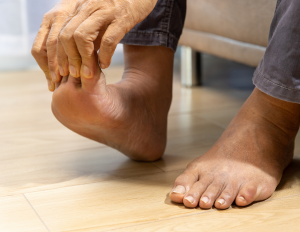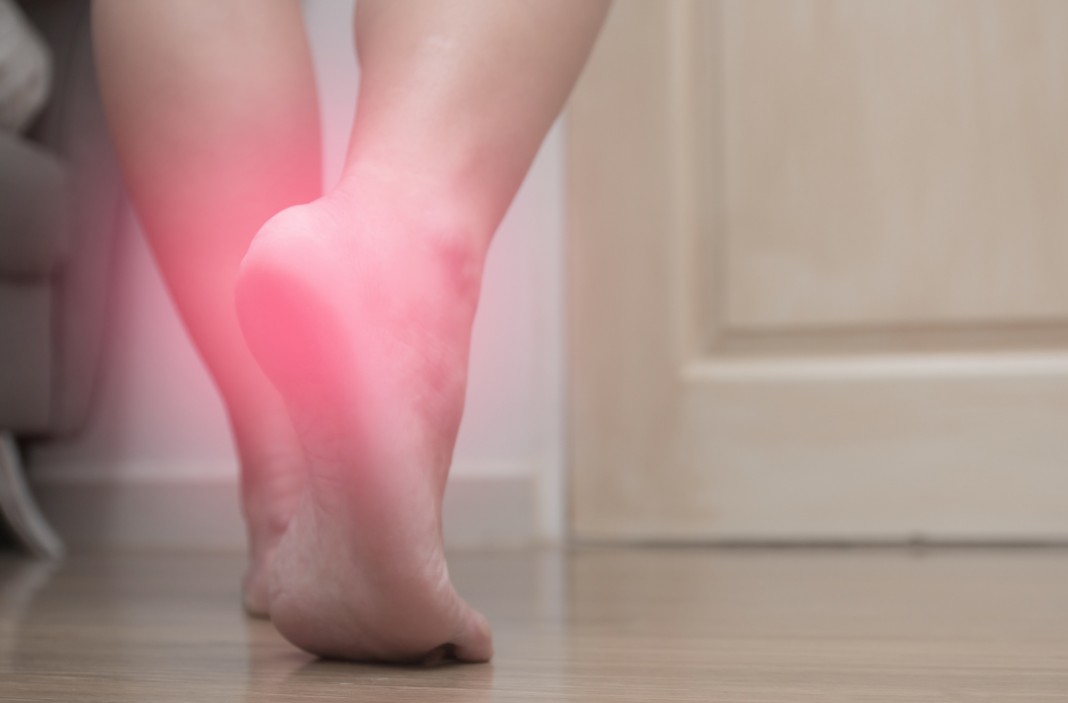Submitted by Penrose & Associates Physical Therapy
Plantar fasciitis is inflammation of the plantar fascia on the bottom of your foot. The plantar fascia is a thick dense tissue and functions more like a ligament then a tendon or muscle. It connects the heel bone to the toes and creates the arch of the foot. The most common complaint is pain and stiffness in the bottom of the heel. The heel pain may be dull or sharp. The bottom of the foot may also ache or burn. The pain may develop slowly over time, or suddenly after intense activity.
- The pain is usually worse:
- In the morning when you take your first steps
- After standing or sitting for a while
- When climbing stairs
- After intense activity

The Specific Cause of Plantar Fasciitis Is Poorly Understood
It is considered an overuse injury that has multiple causes. Some causes are external: training errors (too rapid of increase in miles walked, standing for too long in the last week, or too many miles ran in a week), improper shoes, excessively worn shoes, & running or walking/standing on hard surfaces.
Some causes are internal: if you have limited ankle motion (dorsiflexion), weak plantarflexors (calf), tight calf muscles, malalignment of the lower leg, or if you were born with a foot structure that requires you to compensate and pronate quicker and through more range (excessive pronation) in order to absorb the impact when your foot hits the ground. One contributing factor to developing plantar fasciitis seems to be foot structure; between 81 and 86% of individuals with plantar fasciitis have been found on examination to have excessive pronation (flat feet). Those individuals that have excessive pronation increase the tension placed on the plantar fascia. However, those that have a stiff foot (high arch) have also been implicated to have plantar fasciitis because of this foot type’s inability to effectively absorb the forces during weight bearing activities. Opposite foot types call for different treatment approaches but yet the same problem/diagnosis: plantar fasciitis.
Risk Factors for Developing Plantar Fasciitis
A study examined 50 patients and the most important risk factor associated with developing plantar fasciitis was reduced ankle dorsiflexion (the ability to bring your foot towards your nose keeping knee and leg straight)! The risk of developing plantar fasciitis increased as the motion of ankle dorsiflexion decreased. If you try to squat down to the ground can you keep your heels on the ground? If not you likely have stiff ankles. Other independent factors that increased the risk of developing plantar fasciitis included: obesity and prolonged standing/weight bearing during the work day.
Decreased ankle range of motion creates stiffness and changes the way the ankle and foot mechanics work during walking and running. The big toe (first metatarsophalangeal joint or 1st MTP) is a very important joint when considering push off for walking and running. It is the last joint to have contact as you push off. One study evaluated the motion of the 1st MTP joint in a group of runners that had plantar fasciitis compared to runners without plantar fasciitis. The running group with plantar fasciitis had statistically significantly decreased 1st MTP extension motion (bringing your big toe up – or as when you push off during running/walking), decreased passive extension (you move it with your hands), and decreased passive flexion (you bend or curl the big toe with your hand). This joint is important for pushing off and adequate motion is needed to perform walking and running. Therefore, the big toe joint should be evaluated as part of every standard physical therapy evaluation for plantar fasciitis and treated to increase range of motion if stiff.
Plantar fasciitis is the most common foot condition treated by healthcare providers. About 83% of active adults, ages 25 to 65, will experience plantar fasciitis. It is the most common diagnosis for foot running injuries and making up 10% of all running injuries. The clinical course for most patients is positive with 80% reporting resolution of symptoms at the 12 month follow up. Most patients make significant improvements in 1-3 months with various treatment methods: manual therapy (hands on techniques) to improve ankle and big toe motion, stretching, night splints, taping, and orthotics. The key is having a thorough and accurate evaluation done and then you and your physical therapist can decide which treatment options will work the best depending on the results of the evaluation.
At Penrose Physical Therapy we will give you tools like how to tape the plantar fascia for relief in the acute stage as well as taping for support to see if an orthotic will be helpful. We look at your gait and video tape it and play back in slow motion to see why you are overloading the plantar fascia. If you have a foot or lower leg structure that is not ideal we try to explain what your options are and what you may have to accommodate with inserts or shoes. We use hands on techniques to gain more ankle and big toe mobility and teach you methods to achieve this on your own as well. Most of all we want you to understand the various reasons for why it developed and the various things that can help you get better.
Our team at Penrose Physical Therapy is ready to help you if you have more questions. You can call or text 360.456.1444 or by email at info@penrosept.com.
We are located in Lacey across from Big 5 Sporting Goods and Walmart at 1445 Galaxy Dr. NE Lacey WA 98516. For more information, visit the Penrose Physical Therapy website.

















































